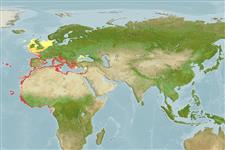Common names from other countries
>
Eupercaria/misc (Various families in series Eupercaria) >
Labridae (Wrasses) > Corinae
Etymology: Coris: Greek, kore, -es = pupil and also with themenaing of "maid" (Ref. 45335).
More on author: Linnaeus.
Environment: milieu / climate zone / depth range / distribution range
Ecologia
marino associati a barriera corallina; distribuzione batimetrica 0 - 120 m (Ref. 27115), usually 1 - 60 m (Ref. 4742). Temperate; 18°C - 22°C (Ref. 27115); 59°N - 1°S, 32°W - 36°E
Eastern Atlantic: Sweden to south of Cape Lopez, Gabon. Also known from the Mediterranean Sea. Specimen of Coris from Cape Verde and Senegal southward are probably Coris atlantica (Ref. 33411), here still treated as a junior synonym pending a definite publication of validity.
Size / Peso / Age
Maturity: Lm ? range ? - ? cm
Max length : 30.0 cm SL maschio/sesso non determinato; (Ref. 2683); common length : 20.0 cm SL maschio/sesso non determinato; (Ref. 4742); Età massima riportata: 7 anni (Ref. 72479)
Spine dorsali (totale) : 8 - 10; Raggi dorsali molli (totale) : 11 - 12; Spine anali: 3; Raggi anali molli: 11 - 12. Snout with 4-6 cephalic pores. Spiny rays flexible. No scales on head and on base of dorsal and anal fins. Vertebrae 25-26. Males: first 3 dorsal rays elongated, with an orange or red and black spot. Along the flanks, a- longitudinal zigzag orange or red stripe. Females and juveniles: a longitudinal large whitish stripe along flanks, a mid-longitudinal zigzag, dark brown stripe.
Occurs in the littoral zone, near rocks and eelgrass beds. Usually found between 1-60 m, but old males stay in deeper water. Found in deeper waters during winter. Sometimes solitary, among rocks, often with numerous specimens in its immediate vicinity. Buries itself in sand at night or when frightened. Feeds on small gastropods, sea urchins, shrimps, worms, isopods and amphipods. Sexually mature when 1 year old. Protogynous species; females change sex to become males; specimen above 18 cm length are all males (Ref. 35388). Pelagic eggs (Ref. 4742).
Females change sex to males before 18 cm TL. Sex reversal is completed in several weeks up to 5.5 months (Ref. 34185, 34255, 35388). Also Ref. 103751.
Quignard, J.-P. and A. Pras, 1986. Labridae. p. 919-942. In P.J.P. Whitehead, M.-L. Bauchot, J.-C. Hureau, J. Nielsen and E. Tortonese (eds.) Fishes of the north-eastern Atlantic and the Mediterranean. UNESCO, Paris. Vol. 2. (Ref. 4742)
IUCN Red List Status (Ref. 130435)
CITES (Ref. 128078)
Not Evaluated
Threat to humans
Harmless
Human uses
Pesca: scarso interesse commerciale; Pesce da pesca sportiva: si; Acquario: Commerciale
Strumenti
Special reports
Download XML
Fonti Internet
Estimates based on models
Preferred temperature (Ref.
115969): 13.3 - 27.7, mean 19 (based on 636 cells).
Phylogenetic diversity index (Ref.
82804): PD
50 = 0.5000 [Uniqueness, from 0.5 = low to 2.0 = high].
Bayesian length-weight: a=0.00871 (0.00742 - 0.01022), b=3.07 (3.02 - 3.12), in cm Total Length, based on LWR estimates for this species (Ref.
93245).
Trophic level (Ref.
69278): 3.4 ±0.1 se; based on diet studies.
Resilienza (Ref.
120179): Medio, tempo minimo di raddoppiamento della popolazione 1.4 - 4.4 anni (K=0.11; tm=1).
Fishing Vulnerability (Ref.
59153): Moderate vulnerability (39 of 100).
Climate Vulnerability (Ref.
125649): Low to moderate vulnerability (28 of 100).
